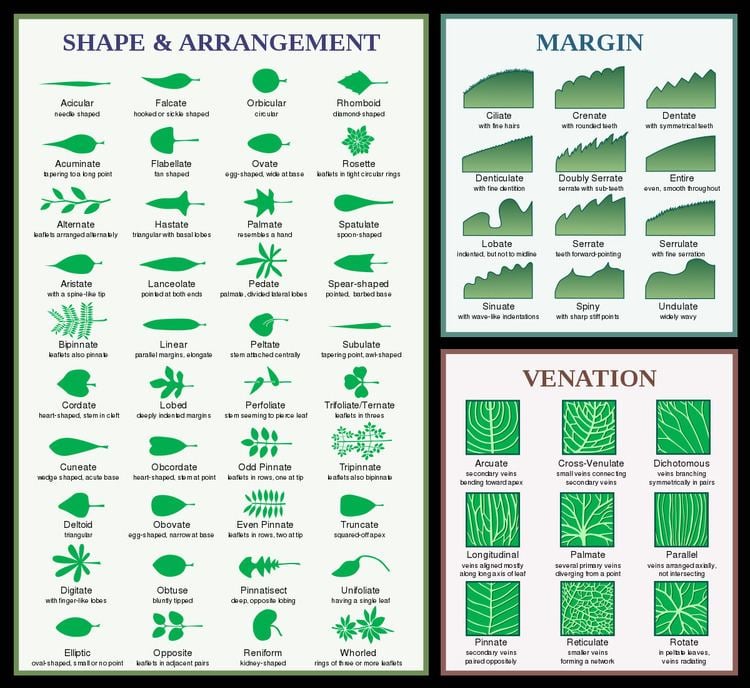Trees can be identified by examination of several characteristics.
The following guide applies to the trees which are indigenous to the region extending from the Atlantic Ocean to the Rocky Mountains and from Canada to the northern boundaries of the southern states, together with a few well-known and naturalized foreign trees.
The typical leaves of a species are to be found upon mature trees, not upon young ones. The leaflets of a compound leaf can be distinguished from simple leaves by the absence of leaf buds from the base of their stems.
To identify a tree check a characteristic and if it is present then examine the characteristics at the next level of indentation. For example, if the tree has simple leaves then see whether the leaves alternate along stem or leaves are opposite along stem.
This guide does not include the Conifers, which are cone-bearing seed plants with vascular tissue.
Simple leaves
Leaves alternate along stem
Margins entire
Oblong-ovate or obovate, large, thick: Magnolia
Oblong, sub-evergreen at the south: Sweetbay Magnolia
Evergreen: Rhododendron, Kalmia
Obovate, 15-30 cm long: Pawpaw
Oblong, thick, shining, 5-12 cm long: Black Tupelo
Oblong, tree occurring sparingly at the north: American persimmon
Heart-shaped: Eastern Redbud
Leaves of three forms; oval, two-lobed, or three-lobed; frequently all three on one spray: Sassafras
Thick, shining, willow-shaped: Shingle oak, Willow Oak
Thick, shining, ovate, spines in the axils: Osage-orange
Broadly oval or obovate, veins prominent, leaves usually in clusters at the ends of the branches: Pagoda Dogwood
Margins slightly indented
Obliquely heart-shaped: Linden
Obliquely oval: Elm
Obliquely ovate: Hackberry
Oval or ovate, doubly serrate: Birch (see Betula classification), American Hornbeam
Repand with spiny teeth: American Holly
Coarsely-toothed, twigs bearing thorns: Black locust
Of quivering habit, petioles compressed: Poplar
Long, slender, finely serrate: Willow
Coarsely crenately-toothed: Chestnut oak
Obovate or oval; wavy-toothed: Witch-hazel
Serrate: Plum, Cherry, Crabapple, Sourwood, Juneberry, Silverbell, Beech
Margins lobed
Lobes entire
Apex truncate, three-lobed: Tulip tree
Lobes and sinuses rounded: White oak
Lobes rounded, lobes 2 or 3: Sassafras
Lobed or coarsely toothed, under surface covered with white down: White Poplar
Lobes slightly indented
Five-lobed, finely serrate: American Sweetgum
Variously lobed, irregularly toothed: Mulberry
Lobes coarsely toothed
Irregularly toothed, lobes bristle pointed: Northern Red Oak
Leaf broad, lobes coarsely toothed: American sycamore
Leaves are opposite along stem
Margins entire
Ovate, veins prominent: Flowering dogwood
Heart-shaped, large: Catalpa
Oval: Fringe tree
Margins serrate: Sweet viburnum, Black haw (Viburnum prunifolium)
Margins lobed: Maple
Compound leaves
Leaves pinnately compound
Alternate
Margin of leaflets entire
Leaflets oval, apex obtuse: Black locust
Leaflets oblong apex acute: Poison sumac
Leaflets oval or ovate: Yellowwood (Cladrastis kentukea)
Leaflets ovate — three in number: Hoptree (Ptelea trifoliata)
Margin of leaflets with two or three teeth at base: Tree of heaven (Ailanthus)
Margin of leaflets serrate: Sumac, Rowan, Walnut, Hickory
Opposite
Margin of leaflets entire: Ash
Margin of leaflets serrate: Ash
Margin of leaflets coarsely toothed: Boxelder Maple
Leaves bi-pinnately compound
Margins of leaflets entire: Kentucky coffeetree
Irregularly bi-pinnate, margins of leaflets entire, thorns on stems above the axils of the leaves: honey locust
Margins of leaflets serrate, stems spiny: Prickly Ash
Leaves palmately compound: Ohio Buckeye, Common Horse-chestnut

